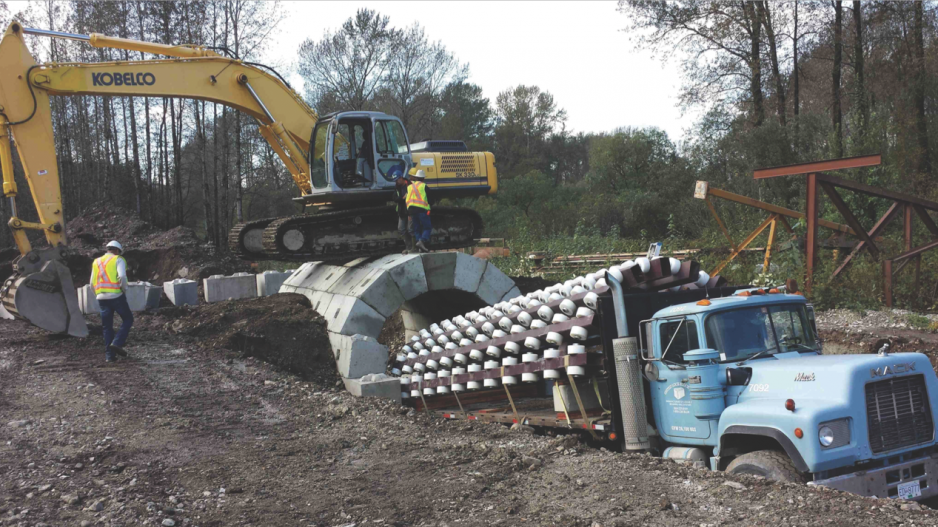A B.C. construction engineering company that has updated an ancient building method for use in modern structures has scored a marketing victory thanks to social media.
It started a few years ago when Brent Wallace, general manager of the Richmond-based Lock-Block Ltd., put together a YouTube video of one of the company’s technologies. (Video embedded below.)
Called Arch-Lock, the patented system uses precast tapered concrete blocks at various cuts to create a small tunnel or covered bridge that vehicles could manoeuvre through. The technology also employs a specialized “zipper” truck with rolling mechanisms. The video showcases the company’s use of the technology to build a three-metre tunnel at a gravel pit on Sumas Mountain, and a 75,000-pound excavator rolling over the tunnel seconds after completion.
Wallace said he got a call from Tech Insider, a subsidiary outlet of Business Insider, a U.S.-based financial and business news website that has international editions all over the world. Tech Insider took Lock-Block’s original 10-minute video, edited it down to a minute and 21 seconds and posted it to its channel and to Business Insider in 2016. The resulting video got more than 61 million views when it made its way to Facebook (Nasdaq:FB), and it peaked on popular post-sharing website Reddit.
“It went viral,” Wallace said. “So it’s been quite amazing, and Daily Planet has also interviewed us. They came out for the day and shot some video, and we constructed one for them.”
The Arch-Lock technology is the brainchild of Lock-Block founder and mechanical engineer Jay Drew, who used to work for Lafarge in the ’70s and ’80s as a division engineer. In 1983, Drew was looking for ways to utilize leftover ready-mix concrete before it set and had to be dumped. He came up with an idea to use the waste concrete to make blocks that look a lot like Lego and can be put together to form retaining walls for gravel. Drew then got the idea of making the concrete blocks in various shapes so they could go around corners, and ultimately to be stacked to create arches.
Armed with his idea, Drew branched out on his own and started the first iteration of Lock-Block.
The Arch-Lock has a number of advantages a regular bridge or tunnel might not have, Drew said. The biggest is its relative simplicity, in that it requires only a small crew, some concrete blocks, an excavator and a zipper truck to put it together.
“The beauty of it is that it’s so simple,” he said, noting the Arch-Lock can reduce construction time by approximately 90%. “And that’s been part of our struggle, is making something simple. And everyone knows simple is always best when you’re down in the trenches trying to make something work.”
He said it all came from visiting Europe in the ’70s, where arch bridges made from concrete or stone are more common, especially in ancient cities such as Rome. “All we’re doing is mimicking the Romans and putting a modern twist on it,” he said. “The Romans didn’t use steel for their structures, so we know it’s possible with concrete if you do it right.”
The company, which uses 3D technology to draw up schematics for each job, recently won a TechGreen award from the Applied Science Technologists & Technicians of BC. Drew and his company have built a few “test” arches, including a bridge for golf carts in Quesnel, and are waiting on engineering permits to be finalized for the Arch-Lock technology so it can expand its clientele.
The company has multiple patents on its technology. Drew said he initially went to a patent lawyer back in the early ’80s who scoffed at the idea, noting that getting approval would be an uphill battle and the chances of getting to market and making a profit would be incredibly hard.
“He said to me, ‘Only one in a thousand of these companies ends up making it.’ Well, I guess I was the one in a thousand. So it turns out that was the worst legal advice I’d ever received.” •
{"preview_thumbnail":"/sites/default/files/styles/video_embed_wysiwyg_preview/public/video_thumbnails/cAE5L07Yil4.jpg?itok=qmvP6zkJ","video_url":"https://youtu.be/cAE5L07Yil4","settings":{"responsive":1,"width":"854","height":"480","autoplay":0},"settings_summary":["Embedded Video (Responsive)."]}




